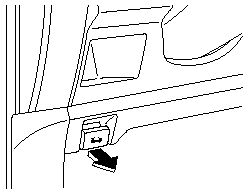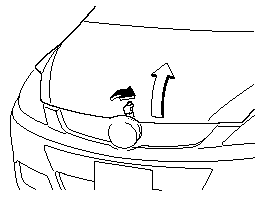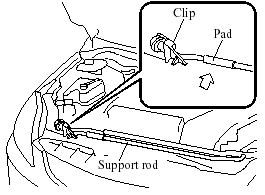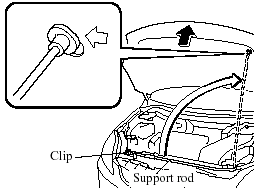Hood
WARNING.
Always check that the hood is closed
and securely locked:
A hood that is not closed and
securely locked is dangerous as it
could fly open while the vehicle is
moving and block the driver's vision
which could result in a serious
accident.
Opening the Hood

1. With the vehicle parked, pull the release handle to unlock the hood.

2. Insert your hand into the hood opening and slide the hood latch to the right and lift the hood.

3. Grasp the support rod in the padded area indicated by the arrow.

4. Secure the support rod in the stay hole indicated by the arrow to hold the hood open.
Closing the Hood
WARNING.
Do not leave items in the engine
compartment:
After you have finished checking or
doing servicing in the engine
compartment, do not forget and
leave items such as tools or rags in
the engine compartment.
Tools or other items left in the engine compartment could cause engine damage or a fire leading to an unexpected accident.
1. Check under the hood area to make certain all filler caps are in place and all loose items (e.g. tools, oil containers, etc.) have been removed.
2. Insert the support rod in its clip while holding up the hood. Verify that the support rod is secured in the clip before closing the hood.
3. Close the hood so that it locks securely.
See also:
Knowing Your Mazda
Explanation of basic operations and controls; opening/closing and adjustment
of various parts. ...
Turn and Lane-Change Signals
Turn Signal
Move the signal lever down (for a left
turn) or up (for a right turn) to the stop
position. The signal will self-cancel after
the turn is completed.
If the indicator light continues t ...
Everyday Driving Fun
The rear-wheel-drive Miata is one of those cars where you don't have to break
any speed limits to have a lot of fun. Driving 55 mph in the Miata is comparable
to going 110 mph in, say, a BMW M3 — ...


